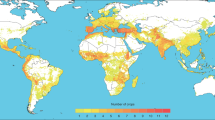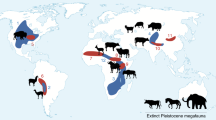Abstract
Thousands of years before the maize-based agriculture practiced by many Native American societies in eastern North America at the time of contact with Europeans, there existed a unique crop system only known through archaeological evidence. There are no written or oral records of how these lost crops were cultivated, but several domesticated subspecies have been identified in the archaeological record. Growth experiments and observations of living progenitors of these crops can provide insights into the ancient agricultural system of eastern North America, the role of developmental plasticity in the process of domestication, and the creation and maintenance of diverse landraces under cultivation. In addition, experimental gardens are potent tools for public education, and can also be used to conserve remaining populations of lost crop progenitors and explore the possibility of re-domesticating these species.
This is a preview of subscription content, access via your institution
Access options
Access Nature and 54 other Nature Portfolio journals
Get Nature+, our best-value online-access subscription
$29.99 / 30 days
cancel any time
Subscribe to this journal
Receive 12 digital issues and online access to articles
$119.00 per year
only $9.92 per issue
Buy this article
- Purchase on Springer Link
- Instant access to full article PDF
Prices may be subject to local taxes which are calculated during checkout



Similar content being viewed by others
References
Hart, J. P. & Lovis, W. A. Reevaluating what we know about the histories of maize in northeastern North America: a review of current evidence. J. Archaeol. Res. 21, 175–216 (2013).
Simon, M. L. Reevaluating the introduction of maize into the American Bottom and Western Illinois. MCJA Occas. Pap. 1, 97–134 (2014).
Simon, M. L. Reevaluating the evidence for Middle Woodland maize from the Holding site. Am. Antiq. 82, 140–150 (2017).
Monaghan, G. W., Schilling, T. M. & Parker, K. E. The age and distribution of domesticated beans (Phaseolus vulgaris ) in eastern North America: implications for agricultural practices and group interaction. MCJA Occas. Pap. 1, 33–52 (2014).
Crites, G. D. Domesticated sunflower in the fifth millennium B.P. temporal context: new evidence from Middle Tennessee. Am. Antiq., 58, 146–148 (1993).
Wills, D. M. & Burke, J. M. Chloroplast DNA variation confirms a single origin of domesticated sunflower (Helianthus annuus L.). J. Hered. 97, 403–408 (2006).
Heiser, C. B. The sunflower (Helianthus annuus) in Mexico: further evidence for a North American domestication. Genet. Resour. Crop Ev. 55, 9–13 (2008).
Cowan, C. W. & Smith, B. D. New perspectives on a wild gourd in eastern North America. J. Ethnobiol. 13, 17–54 (1993).
Kay, M., King, F. B. & Robinson, C. K. Cucurbits from Phillips Spring: new evidence and interpretations. Am. Antiq. 45, 806–822 (1980).
Fritz, G. J. Gender and the early cultivation of gourds in eastern North America. Am. Antiq. 64, 417–429 (1999).
Gilmore, M. R. Vegetal remains of the Ozark bluff-dweller culture. MASAL 14, 83–102 (1931).
Jones, V. H. in Rock Shelters in Menifee County, Kentucky (eds Webb, W. S. & Funkhouser, W. D. ) 147–167 (Univ. Kentucky Press, 1936).
Watson, P. J. & Yarnell, R. A. Archaeological and paleoethnobotanical investigations in Salts Cave, Mammoth Cave National Park, Kentucky. Am. Antiq. 31, 842–849 (1966).
Yarnell, R. A. in The Prehistory of Salts Cave, Kentucky (ed. Watson, P. J. ) 41–54 (Illinois State Museum, 1969).
Yarnell, R. A. in The Archaeology of the Mammoth Cave Area (ed. Watson, P. J. ) 113–122 (Academic Press, 1974).
Ford, R. I. The Nature and Status of Ethnobotany (Univ. Michigan Museum, 1978).
Ford, R. I. Prehistoric Food Production in North America (Univ. Michigan Museum, 1985).
Asch, D. L. & Asch, N. B. in Prehistoric Food Production in North America (ed. Ford, R. I. ) 149–203 (Univ. Michigan Museum, 1985).
Powell, G. Charred, non-maize seed concentrations in the American Bottom area: examples from the Westpark Site (11-MO-96), Monroe County, Illinois. MidCont. J. Archaeol. 25, 27–48 (2000).
Simon, M. L. & Parker, K. E. Prehistoric plant use in the American Bottom: new thoughts and interpretations. Southeastern Archaeol. 25, 212–257 (2006).
Fritz, G. J. Prehistoric Ozark Agriculture: The University of Arkansas Rockshelter Collections. PhD thesis, Univ. North Carolina (1986).
Blake, S. F. A new variety of Iva ciliata from Indian rock shelters in the South-Central United States. Rhodora 41, 81–86 (1939).
Yarnell, R. A. Iva annua var. macrocarpa: extinct American cultigen? Am. Anthropol. 74, 335–341 (1972).
Fritz, G. J. Identification of cultigen amaranth and chenopod from rockshelter sites in Northwest Arkansas. Am. Antiq. 49, 558–572 (1984).
Smith, B. D. & Funk, V. A. A newly described subfossil cultivar of Chenopodium (Chenopodiaceae). Phytologia 57, 445–448 (1985).
Gremillion, K. J. The evolution of seed morphology in domesticated Chenopodium: an archaeological case study. J. Ethnobiol. 13, 149–169 (1993).
Fritz, G. J. in New Lives for Ancient and Extinct Crops (ed. Minnis, P. E. ) 12–43 (Univ. Arizona Press, 2014).
Mueller, N. G. An extinct domesticated subspecies of erect knotweed in eastern North America: Polygonum erectum L. ssp. watsoniae (Polygonaceae). Novon 26, 166–179 (2017).
Mueller, N. G. Documenting domestication in a lost crop (Polygonum erectum L.): evolutionary bet-hedgers under cultivation. Veg. Hist. Archaeobot. 26, 313–327 (2017).
Hunter, A. A. Utilization of Hordeum pusillum (Little Barley) in the Midwest United States: Applying Rindos' Co-evolutionary Model of Domestication. PhD thesis, Univ. Missouri-Columbia (1992).
Yarnell, R. A. in Nature and Status of Ethnobotany (ed. Ford, R. A. ) 289–299 (Univ. Michigan Museum, 1978).
Jackson, R. C. A revision of the genus Iva L. Univ. Kansas Sci. Bull. 41, 793–876 (1960).
Heiser, C. B. Variation and subspeciation in the common sunflower, Helianthus annuus. Am. Midl. Nat. 51, 287–305 (1954).
Heiser, C. B. The Sunflower (Univ. Oklahoma Press, 1976).
Asch, N. B. & Asch, D. L. in The Nature and Status of Ethnobotany (ed. Ford, R. A. ) 301–343 (Univ. Michigan Museum, 1978).
Munson, P. J. Experiments and Observations on Aboriginal Wild Plant Food Utilization in Eastern North America (Indian Historical Society, 1984).
Smith, B. D. Rivers of Change: Essays on Early Agriculture in Eastern North America (Smithsonian Institution, 1992).
Fritz, G. J. An Accidental Gardener: Three Decades of Collecting and Growing Eastern Complex Crops and Their Relatives (SEAC, 2016).
Wagner, G. E. Reflections on Growing Lost Crops (SEAC, 2016).
Mueller, N. G. Seeds as Artifacts of Communities of Practice: The Domestication of Erect Knotweed in Eastern North America PhD thesis, Washington Univ. St. Louis (2017).
Patton, P. & Williams, D. R. Chenopodium berlandieri: A Potential Appalachian Food? (SEAC, 2016).
Horton, E. T. & Carmody, S. B. A Tale of Two Gardens: Integrating Paleoethnobotanical Research and Public Archaeology (SEAC, 2016).
Smith, B. D. & Yarnell, R. A. Initial formation of an indigenous crop complex in eastern North America at 3800 B. P. Proc. Natl Acad. Sci. USA 106, 6561–6566 (2009).
Fritz, G. J. & Smith, B. D. Old collections and new technology: documenting the domestication of Chenopodium in eastern North America. MidCont. J. Archaeol. 13, 3–27 (1988).
Bruno, M. C. in Documenting Domestication: New Genetic and Archaeological Paradigms ( eds Zeder, M. A., Bradley, D. G., Emshwiller, E. & Smith, B. D. ) 32–45 (Univ. California Press, 2006).
Langlie, B. S. et al. Diversity in Andean Chenopodium domestication: describing a new morphological type from La Barca, Bolivia 1300–1250 B.C. J. Ethnobiol. 31, 72–88 (2011).
Gremillion, K. J. Crop and weed in prehistoric eastern North America: the Chenopodium example. Am. Antiq. 58, 496–509 (1993).
Brush, S. B. Genes in the Field: On-Farm Conservation of Crop Diversity (International Plant Genetic Resources Institute, 2000).
Louette, D. & Smale, M. Farmers' seed selection practices and traditional maize varieties in Cuzalapa, Mexico. Euphytica 113, 25–41 (2000).
Perales, H. R., Benz, B. F. & Brush, S. B. Maize diversity and ethnolinguistic diversity in Chiapas, Mexico. Proc. Natl Acad. Sci. USA 102, 949–954 (2005).
Bowers, A. W. Hidatsa Social and Ceremonial Organization (Univ. Nebraska Press, 1992).
Mueller, N. G. Evolutionary bet-hedgers under cultivation: investigating the domestication fo erect knotweed (Polygonum erectum L.) using growth experiments. Hum. Ecol. 45, 189–203 (2017).
Pigliucci, M., Murren, C. J. & Schlichting, C. D. Phenotypic plasticity and evolution by genetic assimilation. J. Exp. Biol. 209, 2362–2367 (2006).
Diggle, P. K. & Miller, J. S. Developmental plasticity, genetic assimilation, and the evolutionary diversification of sexual expression in Solanum. Am. J. Bot. 100, 1050–1060 (2013).
Moczek, A. P. et al. The role of developmental plasticity in evolutionary innovation. Proc. R. Soc. Lond. B Biol. Sci. 278, 2705–2713 (2011).
Mé nard, L., McKey, D., Mü hlen, G. S., Clair, B. & Rowe, N. P. The evolutionary fate of phenotypic plasticity and functional traits under domestication in manioc: changes in stem biomechanics and the appearance of stem brittleness. PloS ONE 8, e74727 (2013).
Piperno, D. R., Holst, I., Winter, K. & McMillan, O. Teosinte before domestication: experimental study of growth and phenotypic variability in late Pleistocene and early Holocene environments. Quat. Int. 363, 65–77 (2015).
Smith, H. & Whitelam, G. C. The shade avoidance syndrome: multiple responses mediated by multiple phytochromes. Plant Cell Environ. 20, 840–844 (1997).
Schmitt, J., Stinchcombe, J. R., Heschel, M. S. & Huber, H. The adaptive evolution of plasticity: phytochrome-mediated shade avoidance responses. Integr. Comp. Biol. 43, 459–469 (2003).
Boutin, C., Aya, K. L., Carpenter, D., Thomas, P. J. & Rowland, O. Phytotoxicity testing for herbicide regulation: shortcomings in relation to biodiversity and ecosystem services in agrarian systems. Sci. Total Environ. 415, 79–92 (2012).
Boutin, C. & Jobin, B. Intensity of agricultural practices and effects on adjacent habitats. Ecol. Appl. 8, 544–557 (1998).
Freemark, K. E., Boutin, C. & Keddy, C. J. Importance of farmland habitats for conservation of plant species. Conserv. Biol. 16, 399–412 (2002).
Yerka, M., de Leon, N. & Stoltenberg, D. Pollen-mediated gene flow in common lambsquarters (Chenopodium album). Weed Sci. 60, 600–606 (2012).
Smith, B. D. The economic potential of Chenopodium berlandieri in prehistoric eastern North America. J. Ethnobiol. 7, 29–54 (1987).
Bermejo, J. E. H. & Leòn, J. Neglected Crops: 1492 from a Different Perspective (FAO, 1994).
Acknowledgements
Funding and support for these projects was provided by the Arkansas Humanities Council, the National Endowment for the Humanities, Arkansas Archeological Survey, Arkansas State Parks, US National Science Foundation Doctoral Dissertation Improvement Grant #58292, the Wenner-Gren Foundation, the Lynne Cooper Harvey Fellowship in American Culture Studies at Washington University, the Sugar Bush Foundation, Voinovich School of Leadership and Public Affairs at Ohio University, and the College of Arts and Sciences at Ohio University. We would also like to thank D. Piperno for her thoughtful comments, and G. Stone for his suggestion that we write this Perspective.
Author information
Authors and Affiliations
Contributions
All authors contributed to writing this article.
Corresponding author
Ethics declarations
Competing interests
The authors declare no competing financial interests.
Rights and permissions
About this article
Cite this article
Mueller, N., Fritz, G., Patton, P. et al. Growing the lost crops of eastern North America's original agricultural system. Nature Plants 3, 17092 (2017). https://doi.org/10.1038/nplants.2017.92
Received:
Accepted:
Published:
DOI: https://doi.org/10.1038/nplants.2017.92
This article is cited by
-
Considering Ideas of Collective Action, Institutions, and “Hunter-Gatherers” in the American Southeast
Journal of Archaeological Research (2023)
-
Mobilizing the past to shape a better Anthropocene
Nature Ecology & Evolution (2021)
-
Archaeological Approaches to Agricultural Economies
Journal of Archaeological Research (2021)
-
Exceptional subgenome stability and functional divergence in the allotetraploid Ethiopian cereal teff
Nature Communications (2020)
-
Does the extended evolutionary synthesis entail extended explanatory power?
Biology & Philosophy (2020)



